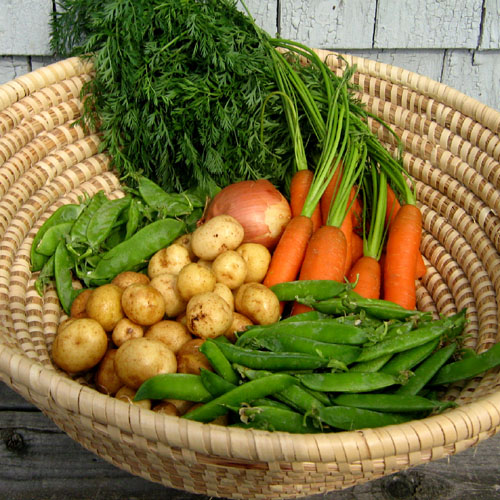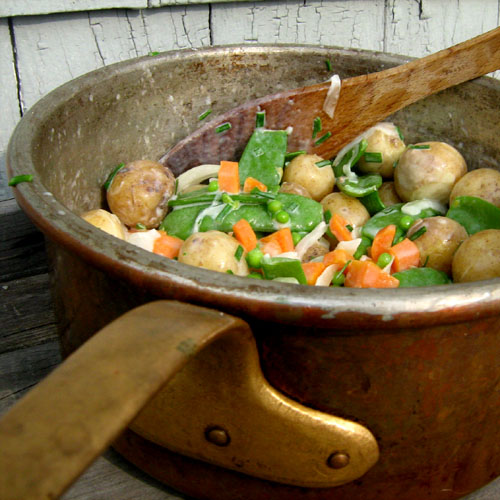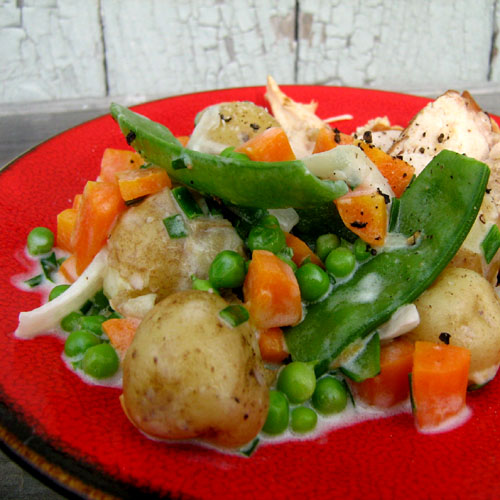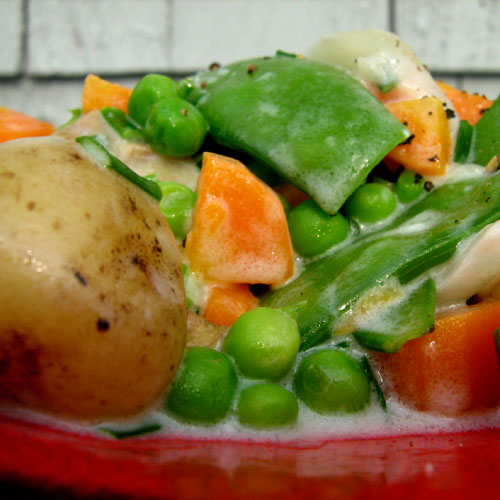-
Posts
4,900 -
Joined
-
Last visited
Content Type
Profiles
Forums
Store
Help Articles
Posts posted by Adam Balic
-
-
Which is why I bought the tree. Two years or so and I will have fruit.
OK, it is freezing here and the wife is away on business so Tripes à la mode de Caen is on the menu. No bovine feet possible, so would it work to substitute pigs feet (for the gelatin, if not the flavour)?
-
My observation would be that there appeared to be plentiful amounts of vegetables in excellent condition at the markets in Cadiz, Jerez and even smaller cities like Sanlúcar. Somebody is eating these and judging from some of the unusual items I saw (especially various wild thistles/milk thistles), some effort is put into obtaining them and they are prized items.
I guess one thing to consider is personal preference vs an empirical measure of what is "best".
I wonder what percentage of foreign reviews on general Spanish food comments in the use of green/unripe tomatoes in salad? This is always given as a negative example of vegetable use, but is it?
While we are on the topic of Spanish veg., I must confess that I quite like some canned Spanish vegetables, especially peppers and white asparagus. In regards to the latter, I consider it a different item to the fresh and simply like it for itself.
Ooof, confessions of enjoying non-al dente and canned vegetables, I imagine this makes me a Philistine...
-
You could use those compress charcoal/coal tablets that are used to burn resin incense in churches. They don't smoke or have a flame, but the whole point of them is that they are hot enough to burn an aromatic, like say your chilli skins. Safer then the sugar cube too.
If it was outside you could try to find some methane ice which would allow you to have a flaming "ice" cube effect......
-
"Coming south from hence we pass'd Stilton, a town famous for cheese, which is call'd our English Parmesan, and is brought to table with the mites, or maggots round it, so thick, that they bring a spoon with them for you to eat the mites with, as you do the cheese."
-
That makes sense, thank you. In Australia there are hundreds of apple varieties, although most people are limited to the usual supermarket selection (which is a slightly different selection to what you find in the UK and USA).
My parents have a small orchard with the apples that you mention, but also a few harder to get types like Calville blanc d'hiver, Court pedu plat etc. Is the wrong time of year here for apples, but I will keep what you have said in mind for next year.
-
Sounds like I did well for a few pounds on ebay.
I'm glad to see that it meets with your approval, as I was un-sure how to judge a cuisine with which I have no experience.
Another question. Apples are used quite a bit in the cuisine it seems, but when using fresh apples (rather then cider or calvados) what type of apples are these? Normandy = cider, but some cider apples are rather horrible to eat raw (some are quite sharp/bitter) and I can't imagine them cooked either. On the other had a super sweet apple doesn't seem right in a savory dish.
-
Ptipois, hae you seen a copy of "The Norman Table: The Tradional Cooking of Normandy" by Claude Guermont with Paul Frumpkin and if so what is your opinion? It is the only English language cookbook on the food of Normandy that I have come across to date.
-
When Daniel Defoe gave the first description of Stilton in the 18th century, it was described as being so covered with mites or maggots that a spoon was provided to eat them.
I imagine that infested cheese might be relatively common.
-
Basmati and related rices are often labelled "aged" as this is an indication of certain desirable characteristics. Aged Basmati has a lower water content and a specific fragrance (smells a bit musty/mousy in the un-cooked state, but gives a characteristic fragrant nutty flavour on cooking). Also aged rice produces a drier, non-sticky rice, so in regions that like dry rice they tend to age it and vise versa.
From memory I thought that the as the rice is aged with the bran intact, fatty acids in the bran break down and generate aromatic molecules, however Harold McGee discusses aging rice here, where he indicates that one of the characteristic flavor molecules of jasmine and basmati rice actually decrease on storage.
I would imagine that there are more then one group of aroma molecules, after all Jasmine and Basmati taste quite different and maybe there is an increase in some of these on aging, but given the data given by McGee, the major effect of aging in on texture.
-
Sounds just like Scottish Tablet as mentioned above.
-
Lamingtons and Meat Pie.
-
Another place of interest is "Bar dell'Orso" near the highway exit for Monteriggioni. Not sure how to describe this, sort of a tavern in the middle of nowhere, with locals and business men from Siena mixing. Basically you order a range of local cured goods, meats, porchetta etc by weight and drink some local wine. Is actually rather good.
-
Thanks very much Johnny, you remind me of the things I had time to do before being a father! "Seafood threat" is an excellent typo BTW!
You may also enjoy this....I don't really like giving restaurant suggestions, but for Da Delphina I would make an exception. However, I haven't been for two years, so it would be worth PMing Divina and finding out what it is like now.
-
Thanks Peter, that is very kind of you. I love the look of the veg. in the Hodge Podge, especially the potatoes. I can almost taste them and feel the "pop" of the skin breaking they look so good.
I'm really pleased to see that Solomon Gundy still exists. As you may know Salmagundi (and various spellings) was an extremely popular mixed salad in the 17th and especially 18th century. In many recipes a main ingredient was pickled herring. The origin of the word is unknown, the oldest form of it is "salmigondin" which was used by the French write François Rabelais in the 16th century. He was fond of nonsense words, so it is possible he made it up or is is related to earlier culinary terms like Salomene etc.
The upshot of all this is that I was pretty amazed to see that that word survived in Nova Scotia. It would be a great lark to make Salmagundi using Solomon Gundy, unless it would make the Universe implode of something.
-
Hodge podge is a hot vegetable dish that I had never heard of until I moved to Nova Scotia. Its the kind of thing you can get at church suppers or in the kitchens of fifth or sixth generation blue nosers. There are many opinions as to what goes in and when it should be made but the fundamentals are always the same: ultra fresh veggies served with cream . . .




I went searching at the farm market in Wolfville, NS on Saturday morning and came home with new potatoes, snow peas, sweet peas and carrots. Onion and chives are softened in butter and the cooked veggies are dumped in with some cream to make it all come together. Purists might insist on salt pork instead of butter to get things going but since I had none butter was more than fine. Other traditional ingredients may include cauliflower, turnips or broccoli.
I'm not clear on the etymology for hodge podge, the non-culinary word I know means a mixture or a random collection of things. There's a French verb that I can't remember but it means to cook with a shaking motion, like you're doing popcorn on the stove.
Both “hotch potch” and “hodge podge” are terms being derived from an Anglo-Norman root “hochepot”, which in term derives from the French term “Hocher” – to shake. While this there is an ancient culinary connection, the other meaning of a jumble or mixture is pretty ancient as well. Chaucer was able to write “but ye han cast alle hire wordes in an hochepot”, with the expectation that people would understand his meaning. Variations on the dish occur all throught western Europe, but in the UK hotch potch/hodge podge became associated with a Scottish dish:
Scotch Hotch Potch (19th century).
"Make the stock of sweet fresh mutton. Grate the zest of two of three large carrots; slice down as many more. Slice down also young turnips, young onions, lettuce, and parsley. Have a full quart of these things when shred, and another of young green peas. Put in the vegetables, withholding half the peas till near the end of the process. Cut down four pounds of ribs of lamb into small steaks, trimming off superfluous fat, and put them in stock. Boil well and skim carefully; and the remaining peas and white pepper and salt; when you think it thick enough serve the steaks in a tureen with the hotch-potch. - Obs. The excellence of this favourite dish depends on mainly on the meat, whether beef or mutton, being perfectly fresh, and the vegetables being young and full of sweet juice, and of being boiled until of good consistance. The sweet white turnip is best for hotch-potch, or the small, round, smooth-grained yellow kind peculiar to Scotland, and almost equal to the genuine Navet of France. Mutton-chops make excellent hotch-potch without any lamb steaks. Parsley shred, white cabbage, aparagus points, or cauliflower may be added to the other vegetables or not at pleasure. The meat may be kept wholeof served seperately."
I've put some more information here if you are interested.
I think that food histoy in Nova Scotia is really interesting. I have a book called "Out of Old Nova Scotia Kitchens" which gives a good account of some of the food traditions of the region. A lot of the recipes (like the hodge podge) have a very 18th century feel to them. Can you still get "Solomon Gundy" cured herring in Nova Scotia?
-
You will be quite close to ristorante Solociccia in Panzano, which is owned by Tuscany's most famously inspired/mad Butcher.
On the otherside of Florence is the lovely Da Delphina in Artimino (the local wine of this region, Carmignano, is excellent).
Also near you is Badia a Coltibuono in Gaiole. There wines are excellent and the grounds are magnificent.
-
As mentioned by salutistagolosa "00" can be very high in gluten/protein. It isn't enough to say to use "00", the flour has to be matched by the purpose for which it is intended. It isn't such a problem in Italy where people know the system, but it is a problem outwith Italy were "00" has been equated with low gluten flour. I'm sure this has caused problems for some peoples cooking and baking. The is big difference between "Farina 00 per dolci soffici" and Farina 00 per pizza" for instance.
-
loose like a stew; browned potatoes on top.
Mill workers woul have had access to, if niot their own, then local communal or baker's ovens.
I'm not sure that there would have been communal access originally, but certainly by the close of the 19th century the hotpot had firmly established itself as the especially dish of mill workers.
However, not everybody in Lanashire was a mill worker and there isn't any evidence to suggest that it originated as a mill workers dish. There is also not evidence to suggest that mutton, pototoes and onions are the only ingredients in Lancashire Hotpot, in fact quite the opposite.
To get back to the original question, mutton and oysters is a pretty classic combination in English cookery, in particular the 18th to early 19th century. One reason for this is that shellfish would act as a natural flavor enhancer. You don't really taste the oysters, but the meat tastes more meaty. McGee mentions that to drive out the salt, shellfish like oysters are very high in free amino acids like glutamic acid, so maybe this is why it works as a natural flavour enhancer.
-
adey73 that is a lovely hotpot dish, it looks terrific.
-
I looked into the origin of the dish a while back and wrote a little about it here.. However, I have some more information now and will have to up-date this post. There is at least one recipe older then the reference given by Davidson (see below). What is important to remember is that this is not a codified dish and issues of what is "authentic" etc are not really relevant. In a recipe like this people used what was at hand, once a somebody says it has to be made in a certain way it suggests that the dish isn't made on a daliy basis.
The early recipes are quite poncy and have oysters and kidneys, two of the earliest recipes are London based, but there is also a Lancashire connection in some of the early recipes. Florence White gives a recipe in the 20th century with is very similar to these (oysters/kidneys) which is said to come from Bolton. So I don't think that there is any reason to suggest that including these ingredients is in some way not a true Lancashire Hotpot. One thing to consider is that at the period when the earliest recipes appear, it is unlikely that the average mill worker would have access to a domestic oven. You can't make a hotpot without an oven, so it's origins are likely to be a bit higher up the social scale.
London at Table 1851
At the bottom of the table, startling as it may sound, let there be a hotpot ; and as we are in a generous frame of mind, we will give to the public at large a receipt for one of the very best, most economical, and easily dressed dishes in the world, as Apollo sings, " Ply me, try me, prove, ere you deny me." The lean part of a loin of mutton, cut into small cutlets. Four mutton kidneys cut into slices, a quarter of a hundred oysters boiled and bearded, four or five potatoes peeled and cut into small slices ; mix the latter together, and put a handful into the bottom of a white earthen pot, or turtle mug, large enough to hold the whole of the above ; then a layer of mutton, oysters, and kidneys, after that a layer of potatoes and onions, then mutton, continually sprinkling pepper and salt betwixt each layer. When the pot is full, pile on the top a good lot of mashed potatoes, and bake in a moderate oven three hours ; before sending to table fill up with good gravy.
The American Stranger’s Guide to London and Liverpool at the Table, 1859
"……followed by a Paté de Lancashire, vulgarly called a "Hot Pot”. As many may doubt the merits of this popular dish,……….the following receipt is given:-.
The lean part of a loin of mutton, cut into small cutlets. Four mutton kidneys pounded, a quarter of a hundred oysters bearded, four or five potatoes peeled and cut into small slices; mix together, and put a handful into the bottom of a white earthen pot, after that a layer of potatoes and onions, then mutton, &c., as before, until the pot is full; continually sprinkling pepper, salt, and a pinch of curry powder betwixt each layer. When the pot is full, pile on the top a good lot of potatoes, bake in a moderate oven three hours; before sending to the table. Fill up with good game gravy."
A Manual of Domestic Economy: Suited to Families Spending from £100 to £1000 a Year by J. H. Walsh, (1857)
Hot-Pot.
Take some fine chops from a neck of mutton, and trim them nicely, taking off most of the fat. Lay them at the bottom of a deep and rather wide dish, season them with pepper and salt. Lay a few slices of onion in the middle at the bottom of the dish, if the flavour is approved, and pour a quarter of a pint of cold water upon the whole. Then cover it with a layer of sliced potatoes, on the top of which lay a few more small chops, well seasoned, and cover all with another layer of sliced potatoes. Bake from an hour to an hour and a half or more, according to the size of the dish; in a very moderate oven
Indian Cookery, Richard Terry, 1861
Hot Pot
Cut 8 pieces of lean mutton the size of a walnut, take the skin from 3 kidneys, and cut each into three; place these in a strong pudding basin, with one onion, 2 potatoes, sliced, a little macaroni, and 3-doz of oysters, season all well with black pepper and salt, fill the basin with stock, and place in an oven ¾ of an hour; take the basin out, and cover the top with mashed potatoes; place again in the oven for half an hour or until brown; when done, pin a napkin round, and serve.
Dinners and dinner-parties by George Vincent 1862
Hot-pot (for eight persons)
A Lancashire dish, is much liked; so much so, that every one at the table always partakes of it, and most persons make their dinner of it. This dish must be made in a fireproof pan, resembling in shape a turtle-mug or cheese-pan. Cut three pounds of rump-steak into square pieces, cut eight or ten potatoes into quarters, some whole small onions, and mushrooms if in season, all well-seasoned with cayenne black pepper and salt, together with a dozen kidneys; place all in layers on the other, pour over them three or four table-spoonfuls of mushroom catchup, and put six or eight dozen oysters at the top, cover it with a crust, and bake for two hours.
A few larks or snipes are a great addition to the above.
-
I don't think that there is an issue with a beef+wine stew existing in Burgundy for a long time, but I still not so sure about beef bourguignonne which is rather a specific dish. If anything the name is specific to the garnish combination then the method for the dish etc. Have yet to see a 19th century reference.
Daube with gnocchi sounds great. I have the niçoise cookbook by the disgraced former mayor which is rather good.
-
Some daubes from further south are served with pasta, so beef stew with wine + pasta isn't that crazy.
I'm not sure that beef bourguignonne itself is such an ancient dish either. Alfred Contour's Le Cuisinier Bourguignon (1931) doesn't seem to have a recipe for it, which is a bit odd if it is an iconic regional dish? Ptipois?
Both Escoffier and Saint-Ange give recipes for the dish, so maybe it didn't start off as a regional dish at all?
I would be surprised if a wine + beef stew didn't exist in Burgundy for a very long time, but the lack of a specifically named dish until relatively recently is a bit odd?
-
Hi all,
I've just bought the Ruhlman and Polcyn Charcuterie book and am eager to start on some of the recipes.
The curing solutions used in a number of the recipes use sodium nitrite in combination with non-iodised salt.
I was just wondering if anyone knows of an Australian-based supplier who sells quantities suitable for domestic use.
While we're at it, does anyone also know of a source for natural sausage casings, also for domestic use?
Thanks

A butcher should be able to supply casings when asked. I bought enough to make thousands of sausages for about $30.
Sodium nitrate is more of a problem. If you look in the local yellow pages under "butchers supplies" you should find a few options. Again you could ask a butcher where they get their supplies from.
-
Looking through the threads there are mostly older posts for Siena and lots of very big ticket steak dinners in Florence, which is not our thing. I am going to have a much too short stay and the sights there are, i am embarrassed to admit, almost as important as the food.
I was hoping you all could help me to combine both.. and also bring some good stuff home. To that end- anyone have any must eats close enough to the Duomo, Uffuzi and Acadameia so I can literally have it all?
I understand Siena is small enough to recommend anywhere in town- so please do. Also, for both towns- what would be the best or most special foodie gifts to look for? What would you want me to bring back for you?
Thanks in advance!
The James Joyce Irish pub Piazza del Duomo has one small table on a small balcony over looking the Battistero di San Giovanni (the wikipedia enty fro this building shows a photo taken from this position). Excellent place for a prosecco/beer and a bit of people watching.



The food of Normandy
in France: Cooking & Baking
Posted
Not impossible (but very difficult). I went to the very large central market here in Melbourne and got two types of tripe (rumen and reticulum). Sad that I can't get abomasum here, as I like the flavor. But I was lucky to get any at all given there are about 20-25 butchers in the complex, but only one of them was selling tripe (+ one selling lamb stomachs). Also the only butcher selling back fat and pork skin.
Anyway, tonight is the night.